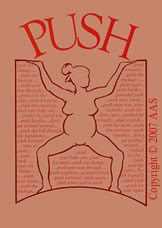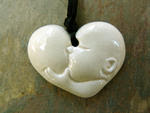 Who hasn’t seen that quote, “If mama ain’t happy, ain’t nobody happy” cross-stitched or painted on something?
Who hasn’t seen that quote, “If mama ain’t happy, ain’t nobody happy” cross-stitched or painted on something?Doctors, women, politicians, and grandmas -- we all know that the United States has the highest maternal death rates of any industrialized nations (see previous post). In obstetric care, maternal and infant mortality rates are like the proverbial “Elephant in the living room” -- that huge monster (addiction, violence, etc.) that everyone knows is there, but the family denies and tries to live around it.
Mother and baby pictured here were low-risk, induced, epidural, emergency cesarean managed by midwives in a naval hospital. They did not reconnect until thirteen hours later. (Medical caregivers did not even mention the baby's brutalized, bruised face -- the Elephant in the nursery!) These interventions, as well as, fetal scalp monitoring, continuous fetal monitoring, artificially rupturing the membranes, vaginal exams, restriction to bed, forceps, vacuum extraction, etc. are known to be violating and disruptive to the mother and baby’s mutual experience of labor and birth.
Violated mothers are wounded mothers. Wounded mothers are not happy mamas, especially when everyone ignores and denies her truth about her experience (her pain, her fear, her powerlessness, her separation from her baby). Wounded mothers are not happy mama, especially when everyone ignores and denies her truth about her experience (her pain, her fear, her powerlessness, her separation from her baby).
The US has the greatest obstetric health care and the highest mortality rates in the world, is there a relationship!?!? What IS the debate and the denial really about? The preservation of the current system of birthing in America is for what reason -- when it is dangerous for women and babies? Why do some in medicine want to separate moms and babies --- both at birth or in looking at safety and mortality? Some say it has more to do with money and power than what is right and safest and healthiest for mothers and babies. Historically, and presently, the data, political support to ignore and maintain the status quo, and the rancor against natural birth suggests that there is something other than maternal and infant safety that is leading policy and protocol decision-making.
What could that be? What could make sense of not following the findings of other countries while spreading our way around the world? Those in the obstetric field are angry when people mention politics and money, but what else is it about? It’s also about the etiology of denial. It's about one’s or one’s society’s collective DENIAL – and, the maintenance and sustaining of it by those who have both been wounded by it themselves and who then become perpetrators cannot see their way out of that place of wounded denial. As Michele Odent and Frederick LeBoyer both state -- birth attendants bring their own birth experiences to the birth of a baby. As Upton Sinclair says, “It’s difficult to get a (wo)man to understand something when his(her) salary depends upon him(her) not understanding it.” The elephant. (Have you seen the movie, “The Secret?” The elephant takes a crap in the living room! And the homeowner is trying to clean it up -- just like how one puts more effort into cleaning up the mess than getting rid of the elephant.)
How long will society be able to deny this atrocious Elephant? Mama's are powerless in decision-making in medical birth and women in many states have minimal options. She must participate in the medical machine and then she gets to live with the consequences -- the Elephant and it's crap.
Basically, the elephant DENIAL and resistance to CHANGE is about:
1) Money – getting and keeping
2) Power – getting and keeping
3) Status – getting and keeping
4) Denial and fear of change, losing status and income, and litigation
5) Inability to see how to deal with own pain and behavior -- because of generations of perpetuating the belief that babies “don’t remember birth” (pain or joy, apparently)
Whether is it literally at birth or figuratively as in the debate over research about where birth is safer for baby, forcing a baby's labor, drugging a baby, and separating moms and babies is harmful. Truly, what is the purpose of these scientifically disregardful actions of the medical system, if for no purpose but self-perpetuation and preservation? Where are the fighters for the protection of children, including every state division of child protective services? Where are the feminists who fight for women's rights for everything from equal pay to quality health care to childcare and family leave? Flat on their backs with narcotics going directly into their spinal cord system apparently. Sisters, get up!! Say "No to drugs and say yes to ME, and Yes! to my baby!" (One of the early elementary prevention programs I did in the early nineties was, "Say no to drugs; Say YES! to ME!" with the belief that children needed an alternative to no. Sort of an attachment parenting sort of concept, eh?)
Clearly the debate (of one study by Johnson and Daviss) over safety about home versus hospital birth has to eventually switch to some obvious issues and the bigger picture of maternal safety and the consequences to her and baby when drugs and technology are misused. The now routine use of life-saving interventions and drugs meant for at-risk and high-risk women that are being routinely misused on low-risk women and babies are what separates mothers and babies.
(See post http://hospitalbirthdebate.blogspot.com/2007/01/self-attachment-home-and-hospital.html.attachment-home-and-hospital.html
Physiologically and emotionally induction and drugs separate the mother and baby during labor and birth. (See picture of mother on oxygen after hours of labor with induced Pitocin and epidural anesthesia.) Physically and emotionally caregivers separate the mother and baby post-birth for medically unnecessary interventions that do nothing but service staff convenience, schedule, and liability issues on the conveyor belt of birth.
Mother and baby pictured here were low-risk, induced, epidural, emergency cesarean managed by midwives in a naval hospital. These interventions, as well as, fetal scalp monitoring, continuous fetal monitoring, artificially rupturing the membranes, vaginal exams, restriction to bed, forceps, vacuum extraction, etc. are known to be violating and disruptive to the mother and baby’s mutual experience of labor and birth. Violated mothers are wounded mothers.
Wounded mothers are not happy mamas, especially when everyone ignores and denies her truth. Where is our social and political will, and our personal compassion to support women to give birth gently and safely, and to heal? country? Zoloft, Paxil, and Celexa are not the solution to making mamas happy.








No comments:
Post a Comment